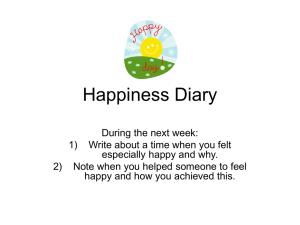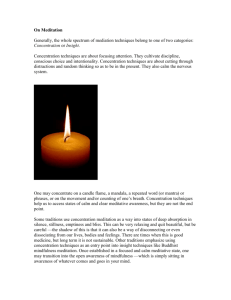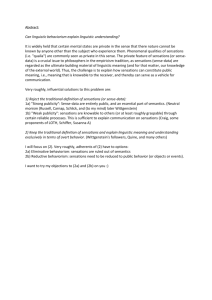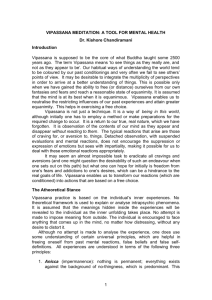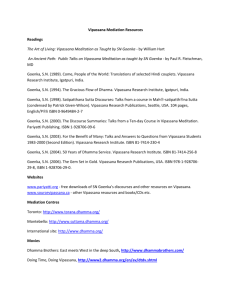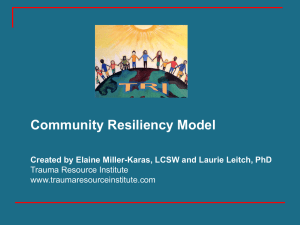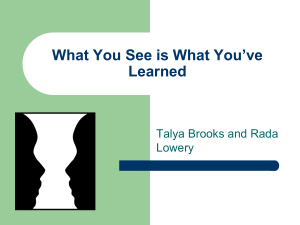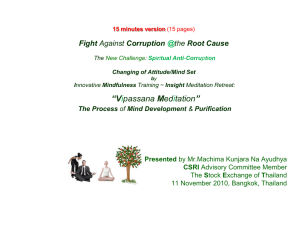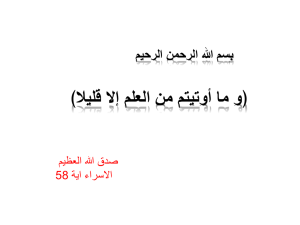Transforming the Politics of Experience: the case of Vipassana
advertisement
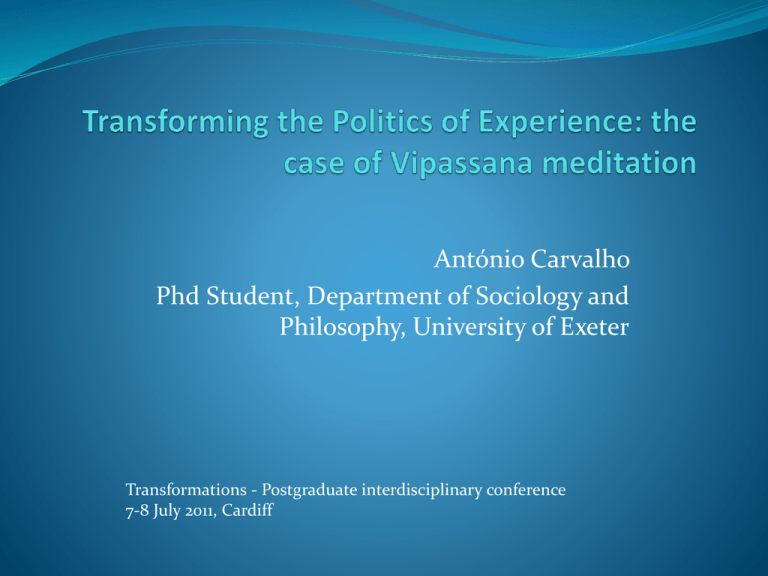
António Carvalho Phd Student, Department of Sociology and Philosophy, University of Exeter Transformations - Postgraduate interdisciplinary conference 7-8 July 2011, Cardiff Introduction Case study of my ongoing research Reflection on technologies of the self, ontology and the “social” Methodology- Literature research; participant observation in a 10-day retreat; reports of experiences with Vipassana; ongoing interviews Structure of Presentation – Introductory remarks on Vipassana; three technologies of meditation; processes/axes of subjectification; Vipassana and politics of experience; “Social” Applications; Final reflection Vipassana and ontology of the body/self - “the systematic development of insight through the meditation technique of observing the reality of oneself by observing sensations within the body” (Hart, 1987: 164) Vipassana meditation Body/impermanent - empty space and subatomic particles, deprived from solidity and impermanent; kalapas, - units that express the four aspects of matter - mass, coherence, temperature and movement. Bodies as vibration of impermanence, a dance of aggregates of kalapas, a process of constant somatic becoming. Mind as four processes – consciousness, perception, sensation, reaction: Sankharas (reaction) – craving and aversion towards sensations, the nature and fuel of the mind Importance of (meditative) experience to overcome this condition - 10-day retreat Organizational aspects Morality: 1) to abstain from killing any being; 2) to abstain from stealing; 3) to abstain from all sexual activity; 4) to abstain from telling lies; 5) to abstain from all intoxicants. Other aspects: Acceptance of the Teacher and of the Technique ; No other Techniques, Rites, and Forms of Worship; Noble Silence ; Separation of Men and Women ; No Outside Contacts ; No Music, Reading and Writing Schedule: 4:00 a.m. Morning wake-up bell/ 4:30 . 6:30 a.m. Meditate in the hall or in your room/ 6:30 . 8:00 a.m. Breakfast break 8:00 . 9:00 a.m. Group meditation in the hall/ 9:00 . 11:00 a.m. Meditate in the hall or in your room according to the teacher’s instructions/ 11:00.12 noon Lunch break/ 12:00.1:00 p.m. Rest, and interviews with the teacher/ 1:00 . 2:30 p.m. Meditate in the hall or in your room 2:30 . 3:30 p.m. Group meditation in the hall/ 3:30 . 5:00 p.m. Meditate in the hall or in your room according to the teacher’s instructions/ 5:00 . 6:00 p.m. Tea break 6:00 . 7:00 p.m. Group meditation in the hall/ 7:00 . 8:15 p.m. Teacher’s discourse in the hall/ 8:15 . 9:00 p.m. Group meditation in the hall 9:00 . 9:30 p.m. Question time in the hall/ 9:30 p.m. out Retire to your room; lights Anapana Sati Sitting meditation – cross legged; half-lotus; knee posture; chairs; upright position; closing eyes and mouth; The meditator observes the various sensations created by the touch of the breath inside, at the entrance or below the nostrils, both inspiring and expiring –awareness of the sensations caused by the breath entering and leaving the nostrils, focusing on a single object to develop concentration. Initial experiences . As one starts observing the breath coming in, going out, the nature of the “monkey mind” manifests, wandering into the past and the future. It is very difficult to concentrate on the present. The body reacts against the posture with pain, aches and discomfort. With practice, the mind is able to concentrate on the breath, creating episodes of calmness and relaxation, becoming stable and still. In advanced stages of concentration, it is common to experience visions, to see “divine” lights or hearing extraordinary sounds, while experiencing oneness with the object of meditation. Preparation for Vipassana Vipassana Body Scan – head to feet and feet to head (4th day) Observing sensations with awareness and equanimity (somatic gaze) One may not feel sensations at all, or one may feel sensations in some parts of the body and other parts can be blind spots. Gross sensations and subtle sensations. Gross sensations are solidified, unpleasant sensations (pain, itching, trembling, heat, cold). Most common at the beginning, but they can turn into subtle sensations - a flow of vibrations of energy. With no generation of new sankharas – equanimity – old ones emerge. Sankharas and Bangha “Sometimes you’ll spontaneously become aware of an emotional event associated with sensations. When passing my attention across my cheek during my first retreat (…) I felt a stinging at the same time I had a memory of my brother slapping me across the face. This had happened when I was a kid and I hadn’t thought of it in years, but obviously in some way it was still there” (Glickman, 2002: 105) No necessary correlation between sensations and episodes of the past - they can be caused by vary different aspects, such as atmospheric conditions, the posture in which one sits, the effects of a disease or weakness or even the food Psychological insights about the self - “(…) sitting with “no effort”, I realized that sensations come naturally and go naturally. They come and go not because I am doing something but because of their nature. At the same time I could see myself, how proud, how self-centered, how selfish, I was. These experiences were things I will not forget for my whole life” (Hetherington, 2003: 49) Bangha – as the scanning continues, blind/gross spots/sensations may turn into subtle ones, and the body is felt as a current of vibrations, the body is felt as in dissolution - “(…) I experienced a very deep stage of bhanga in which my entire body seemed to have dissolved into a mass of vibrations constantly arising and passing away. Even if by chance I happened to look at someone, I saw only the outline of that person and within it a kind of blinking or oscillation.” (Goenka, 1991: 139) Metta, a technology of Compassion (10th day) - ideally practiced while experiencing the free flow – pure mind. While experiencing one’s vibrations, the meditator expands or radiates this energy out into the world, sharing them as wholeheartedly as possible (Glickman, 2002: 101) If there are gross sensations, one just works with a sentence - “May all beings be peaceful. May all beings be kind. May all beings be happy” (ibid). Metta can be understood as a technology of compassion, irradiating the same blissful and loving feelings experienced in deep stages of Vipassana. It also configures new possibilities of communication and intervening in the world. Metta is used by Goenka, assistant teachers and volunteers at the retreats to help the students “progressing” Forms of Subjectification I Discipline - Rules of an organizational nature; physical aspects of discipline – sitting in straight position, regulation of sleep and of diet; mental discipline of awareness and equanimity towards the meditative self. Environment – organizational aspects with “vibrational” foundation (special ontology) – segregation to avoid multiplication of passional vibrations; meditators in the same place generate good vibrations; vibrations of Buddha’s relics and the Vipassana Global Pagoda (inaugurated in 2009) Forms of Subjectification II Struggles of Agency – Actants such as Memories of the past, desires of the future, pain, discomfort, strange visions and dreams, different physical manifestations, OBEs contribute to disturb one’s equanimity creating a conflict with the pure awareness of equanimous observation. Hermeneutics of Experience – a) Performative dimension - ways of using the body and the mind that modulate inner experience. One sits in a certain way, closes the eyes and the mouth, focuses on a specific part of the body , observing sensations. Performative interpretation/response to the experience of the body/self.; b) Discursive Dimension – Discourses every night; Interviews with the Assistant Teacher – making sense of the experience with concepts, inter-subjective dimension. Vipassana’s Politics of Experience I - The Role of the Body Body and sensations produce a new politics of experience. 1) Observation of sensations and liberation; 2) through the body we unveil hidden episodes of reaction, the sankharas 3) through the body we become aware of what is going on with the mind, and through the equanimous observation of the breath and sensations we can “modulate” the experience of the mind; 4) experience of the dissolved body and ontological nature of things; 5) through discipline and specific performances of the body the self is transformed; 6) the body gives us the “truth” about ourselves and the world Overcoming Stability –In Bangha, the body is just energy - some users report experiencing a dissolution between the boundaries of the body and the environment. With practice, increasing awareness of vibrations – of other people, of places - self, environment, other humans and non humans and vibrations from the past are part of the same assemblage of entities that can affect each other. Politics of Experience II Agency - the freedom to choose beyond desires, frustrations, anger, and the untamed “monkey mind”; self-regulation through the awareness of the body. Ethics - Ethical transformations are linked to the ontological transformation of the self. With equanimity, the subject can observe and monitor changes in the breath or in body sensations. With meditation it is possible to cultivate an attitude of observation towards negative emotions; Cultivation of positive emotions towards others (Metta) – a) embodied ethics; b) ethics rooted in the direct experience of the self; c) non-individualistic ethics Vipassana and the Social What is the social? Individuals and their sensations/minds. To transform social, first subjectivities have to be transformed. Vipassana and Government – examples of King Ashoka and U Ba Khin (good emotions and the ruler; Vipassana and the fight against corruption) Vipassana and Prisons - 1975, central jail of Jaipur, India. After that, Taiwan, Thailand, Nepal, USA, New Zealand and Britain. India – since 1994, approximately 26 prisons are conducting Vipassana courses regularly. All India Institute of Medical Sciences - awareness of emotions, reducing anger, hostility, tension and hopelessness. Drug addiction and neurotic and psychopathological symptoms are also reduced - instead of promoting a normalization or domestication of the deviant self, social empowerment through emotional/somatic education? “just as oppressive power relations are encoded and sustained in our bodies, so they can be challenged by alternative somatic practices.” (Shusterman, 2008: 22) Vipassana and Education - Since 1986, courses in schools (1-2 days) and in Vipassana centers (2-3 days), for children between 8 and 15 years old. They learn Anapana. Education focuses on emotional and spiritual aspects, This incorporation of meditation in education overcomes the verbal mainstream model, presenting interesting possibilities. Huxley’s idea of non-verbal humanities, “the arts of being directly aware of the given facts of our existence” (Huxley, 1963: 62) Reflection Technological constitution of selves – practices and performances transform the somatic and mental experience of selfhood, creating altered states of consciousness, different embodied ethical perspectives, different ways of “existing” as humans De-naturalizating the constitution of individuals – if there is a relationship between technologies of the self and ontologies of the self, we are invited to question our common and mainstream ways of reproducing, maintaining and stabilizing selfhood. If selves depend on practice, environments, different assemblages, the ontology of selves is always political. Ontological politics of selves – what kinds of selves do we want to be? What kinds of performances can we undertake in order to change our constitution and relationship with humans and non humans? The social – We can question the role of institutions and forms of contemporary governmentality concerning subjectification; how are these politics of subjectification transformed with the inclusion of certain practices; how can technologies of the self be mobilized to transform the social, also transforming the fabrication of selves, promoting new ways of experiencing the body and reality?
